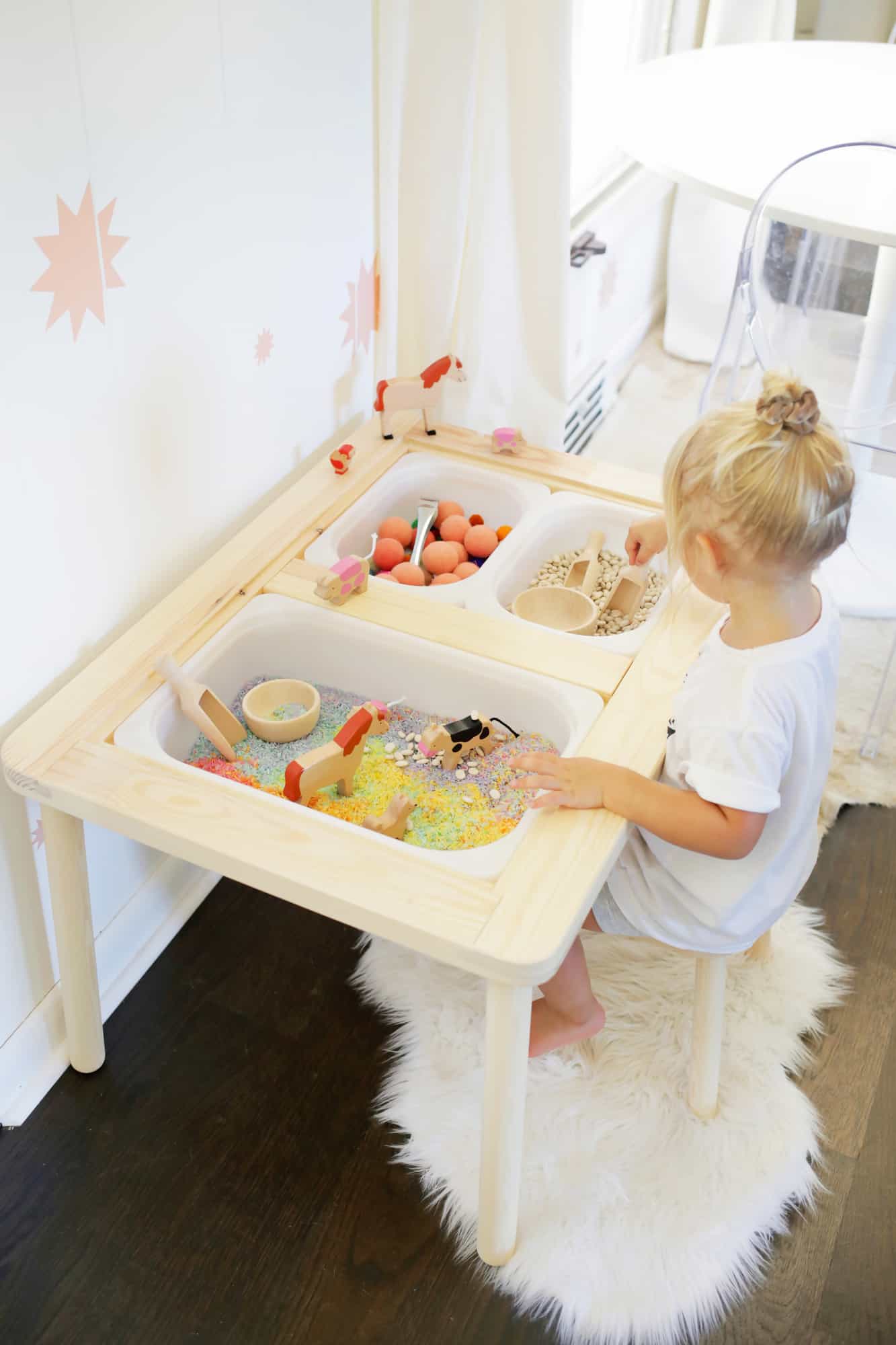 If you’ve searched for anything kid-related on Pinterest even once, you’ve probably had your feed instantly flooded with “sensory bin” ideas all of a sudden and there’s a good reason why! Kids love bins filled with different small items that they can either scoop into bowls or tubes, pour back and forth, and play with animals or cars in the mixtures. It’s crazy how much some toddlers love to play with these and I think you’ll find that it’s pretty fun for the grownups too!
If you’ve searched for anything kid-related on Pinterest even once, you’ve probably had your feed instantly flooded with “sensory bin” ideas all of a sudden and there’s a good reason why! Kids love bins filled with different small items that they can either scoop into bowls or tubes, pour back and forth, and play with animals or cars in the mixtures. It’s crazy how much some toddlers love to play with these and I think you’ll find that it’s pretty fun for the grownups too!

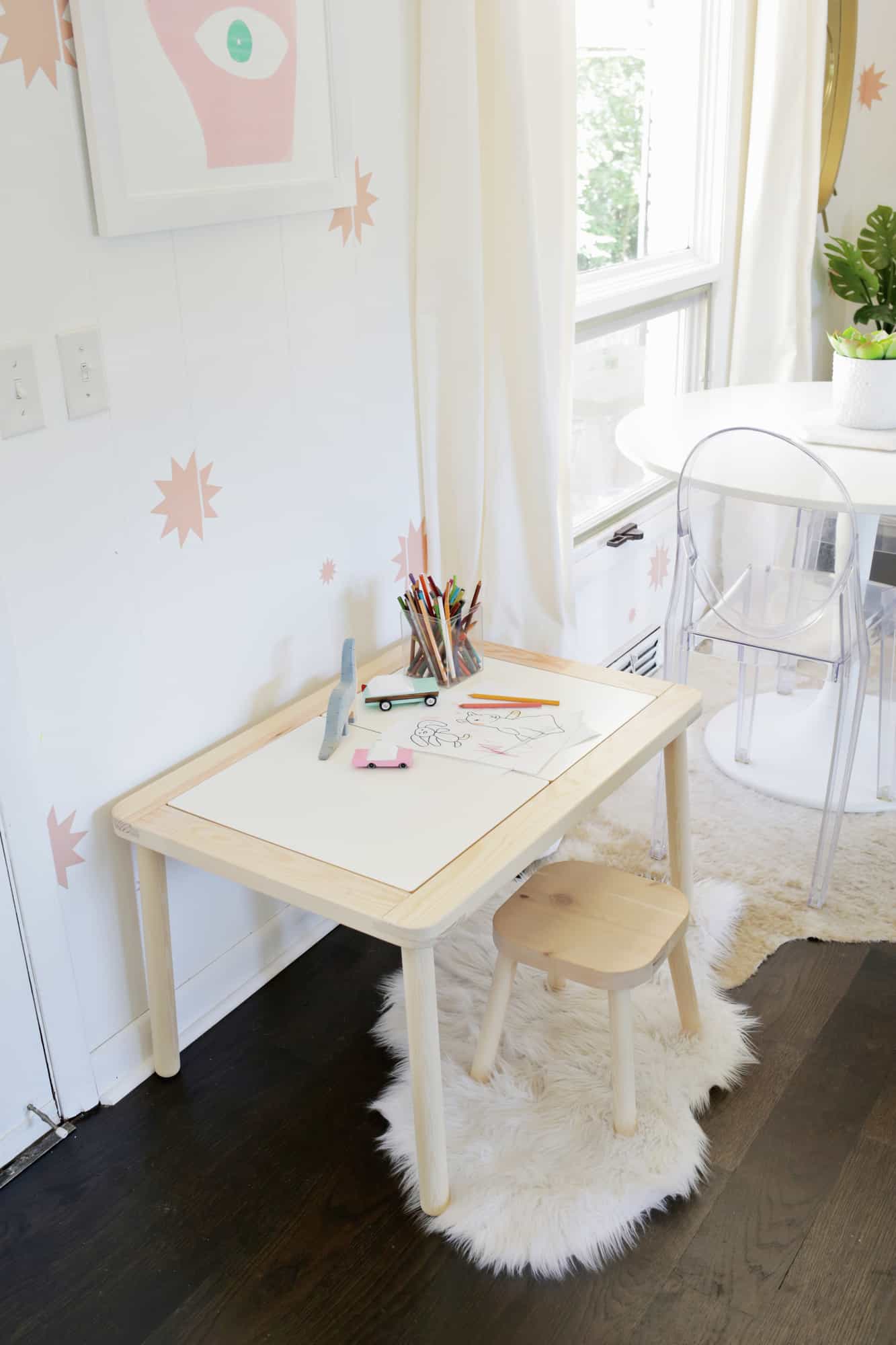 The Sensory Table: I saw online that a few people have converted this Ikea desk into a sensory table and it’s still my favorite idea so far, so it’s the one that we went with. I bought two of these bins and lids to fit on one side and a larger bin to fit on the other side so that gives us three different areas she can play in. We also got her a little stool to use at the table and since it slides under the table when not in use, I think I’ll get another one for us or a friend to sit on as well. We live in a relatively small house (that my husband and I both work out of, so it feels extra small at times), so I didn’t really want a table that was only for sensory place. So I love that we can put the lids back on the desk and it’s also a table for coloring, eating, whatever she wants to do at her height. The table is also pretty light, so if you wanted to take it outside on a porch or something on a nice day, you totally could. I just wouldn’t leave it outside overnight to prevent moisture from invading your bin contents.
The Sensory Table: I saw online that a few people have converted this Ikea desk into a sensory table and it’s still my favorite idea so far, so it’s the one that we went with. I bought two of these bins and lids to fit on one side and a larger bin to fit on the other side so that gives us three different areas she can play in. We also got her a little stool to use at the table and since it slides under the table when not in use, I think I’ll get another one for us or a friend to sit on as well. We live in a relatively small house (that my husband and I both work out of, so it feels extra small at times), so I didn’t really want a table that was only for sensory place. So I love that we can put the lids back on the desk and it’s also a table for coloring, eating, whatever she wants to do at her height. The table is also pretty light, so if you wanted to take it outside on a porch or something on a nice day, you totally could. I just wouldn’t leave it outside overnight to prevent moisture from invading your bin contents.
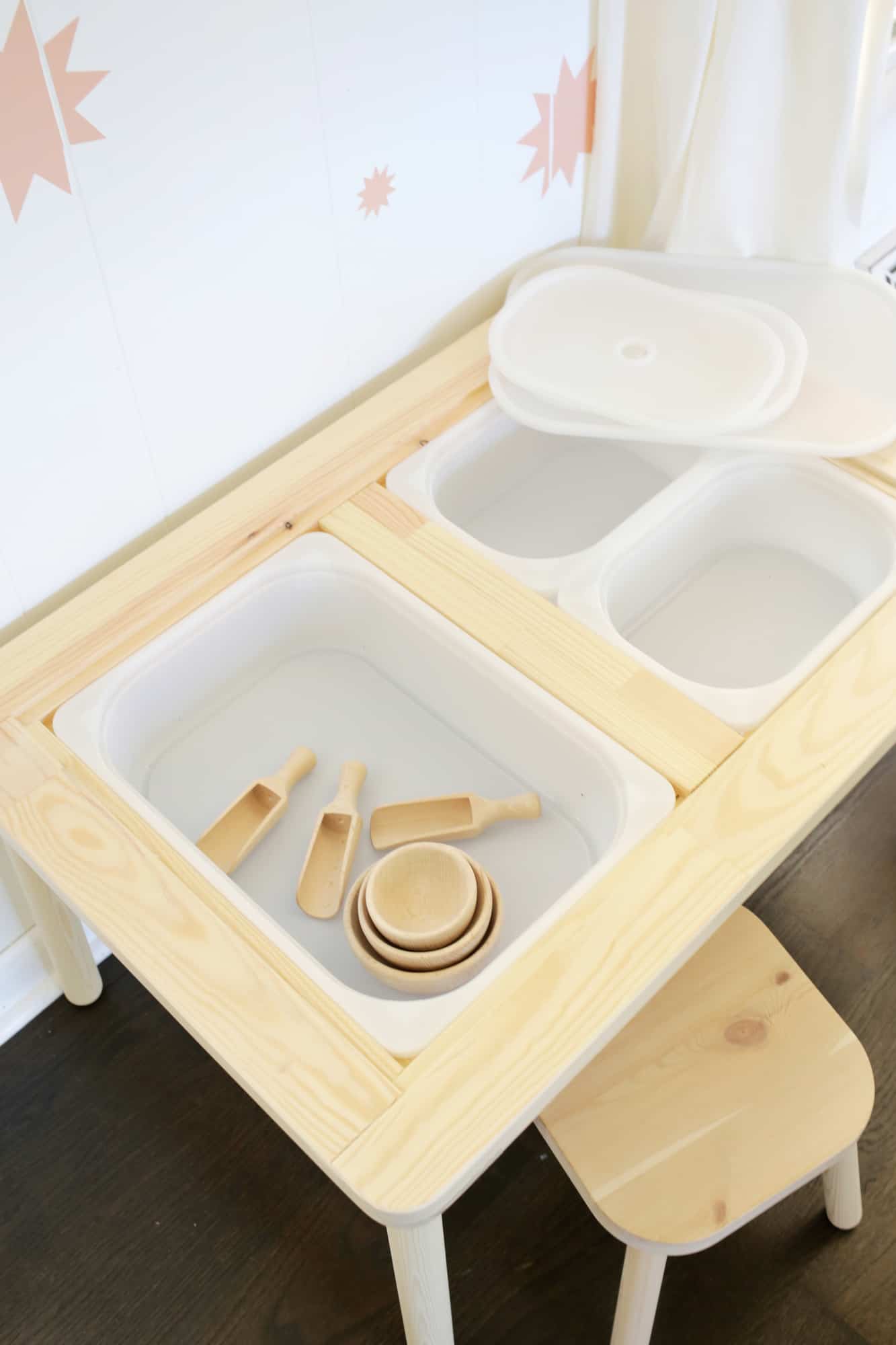
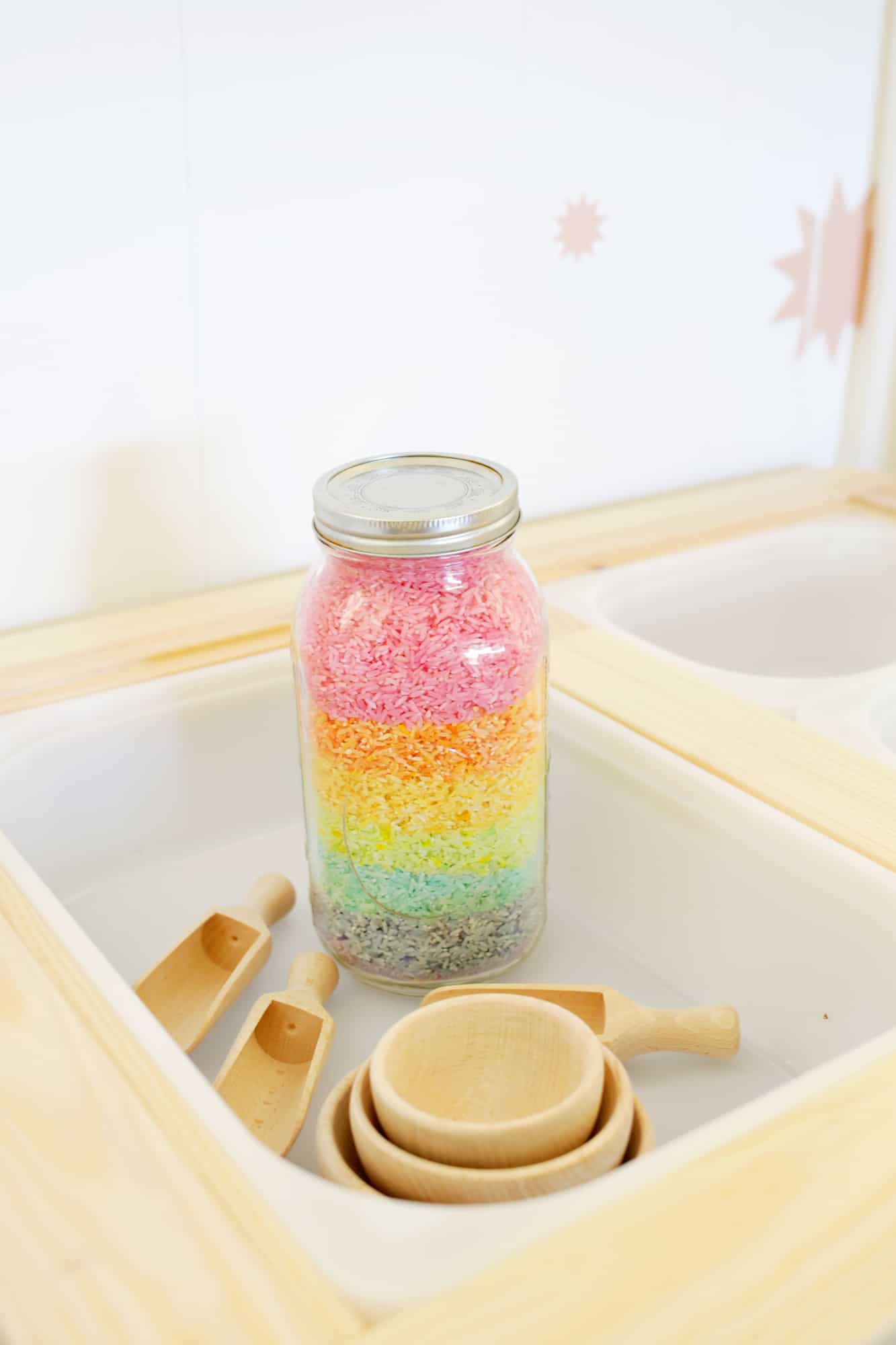
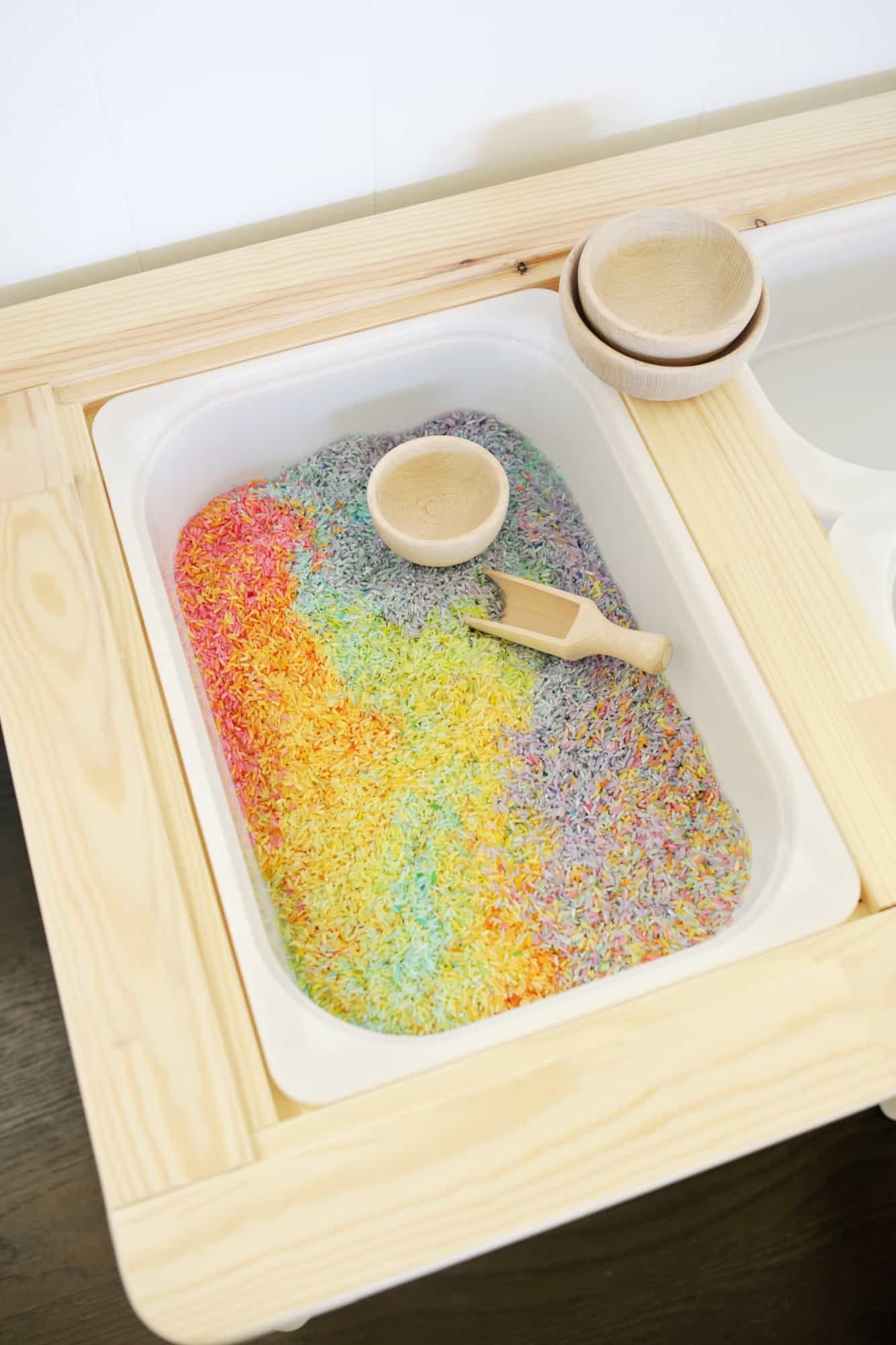
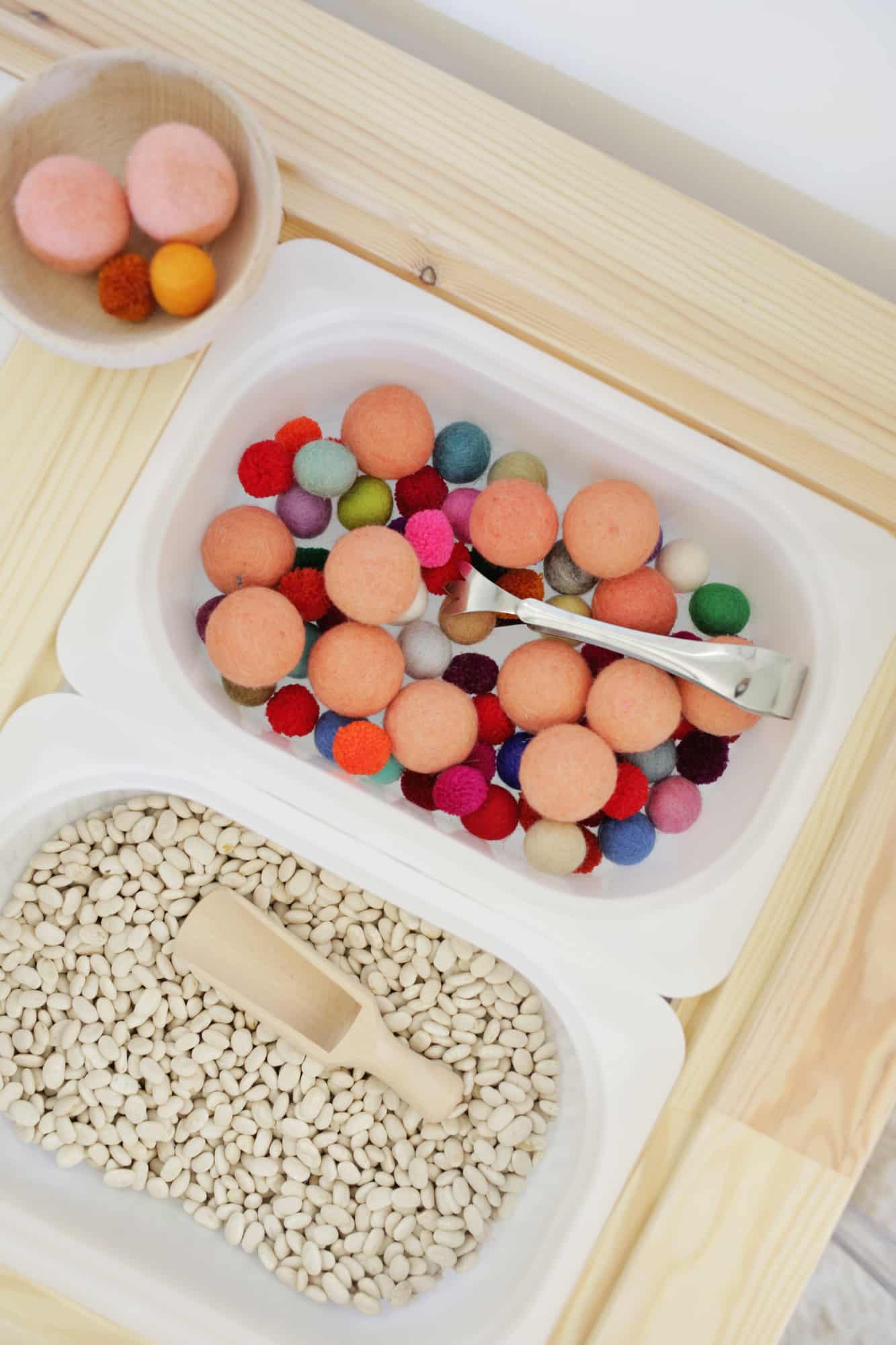
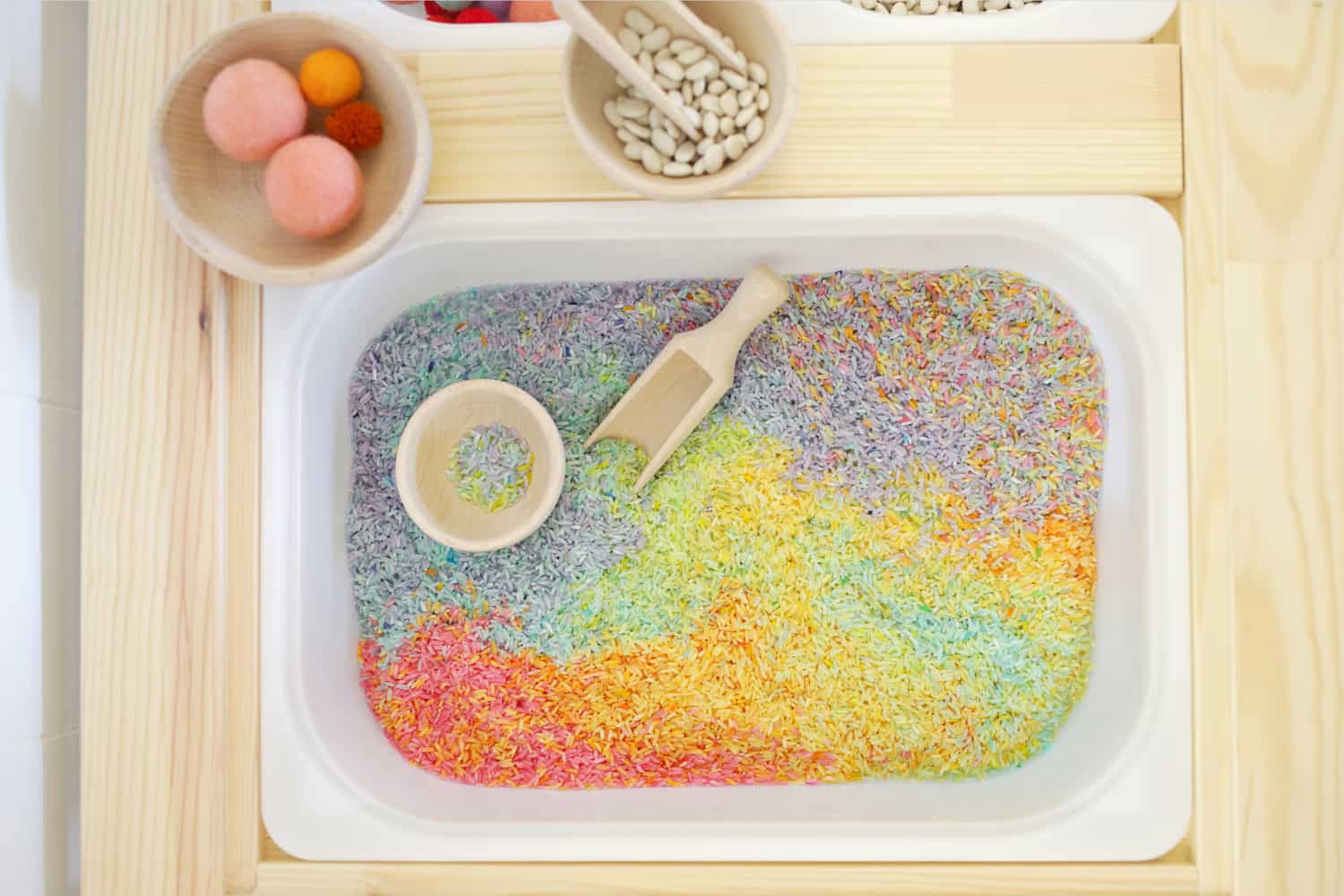 The Bin Supplies: You can fill your bins a few inches deep with age-appropriate items like dried rice/beans/pastas, pom poms, wool balls, dirt, rocks, water, sand—whatever you like! Just make sure to keep in mind what might be a choking hazard size for younger toddlers and wait until they are past the age of wanting to eat the dried food items if using those. For extra fun, you can also dye colored rice for your play (there are ways to dye noodles and beans as well).
The Bin Supplies: You can fill your bins a few inches deep with age-appropriate items like dried rice/beans/pastas, pom poms, wool balls, dirt, rocks, water, sand—whatever you like! Just make sure to keep in mind what might be a choking hazard size for younger toddlers and wait until they are past the age of wanting to eat the dried food items if using those. For extra fun, you can also dye colored rice for your play (there are ways to dye noodles and beans as well).
I love these wooden nesting bowls and scoops for the bins and tongs can be fun too, but really you can use any measuring cups/spoons/bowls you may have handy. Lola also likes to fill up toilet paper tubes as well, so those are free and you can recycle them when you are done.
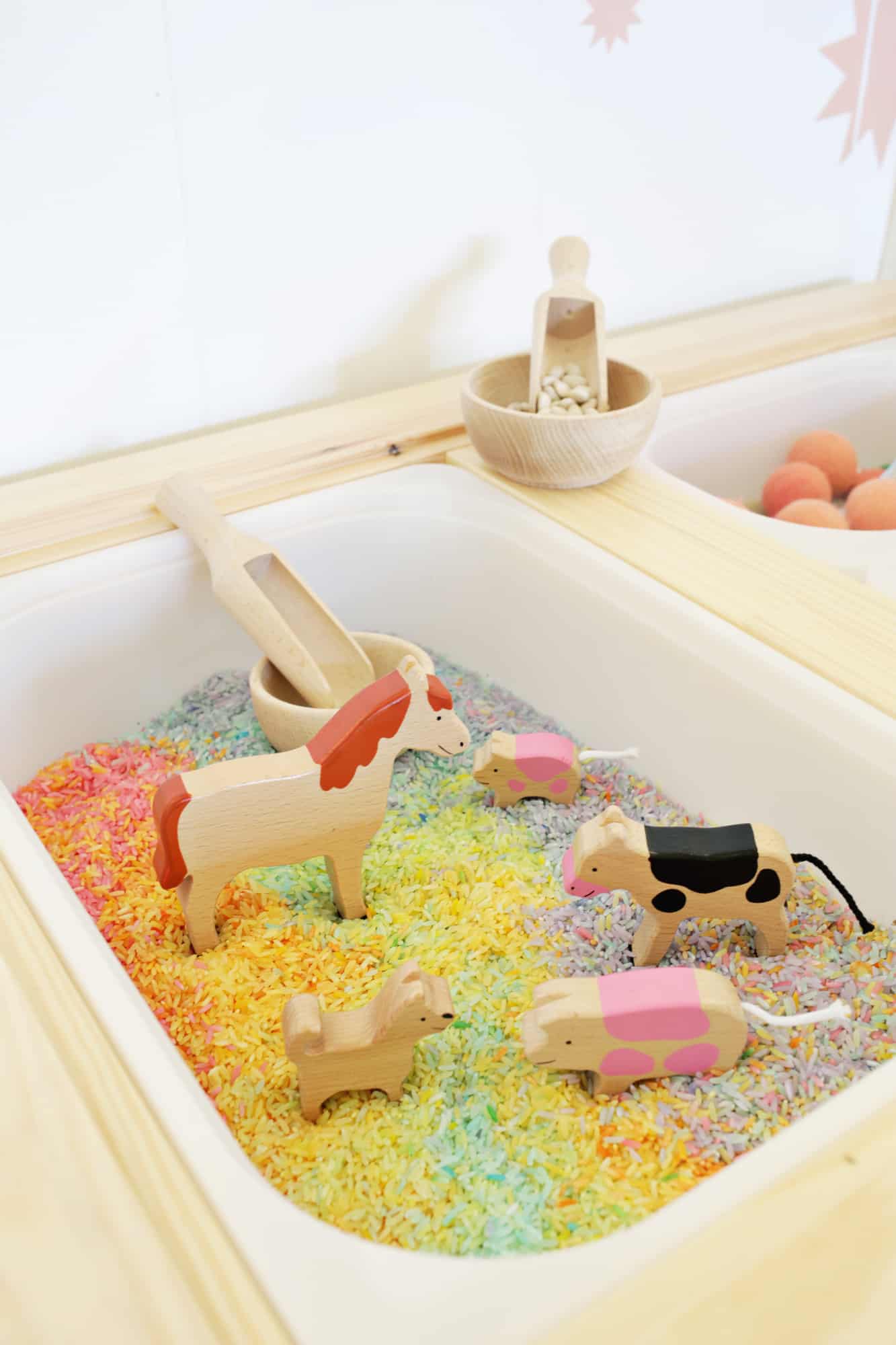
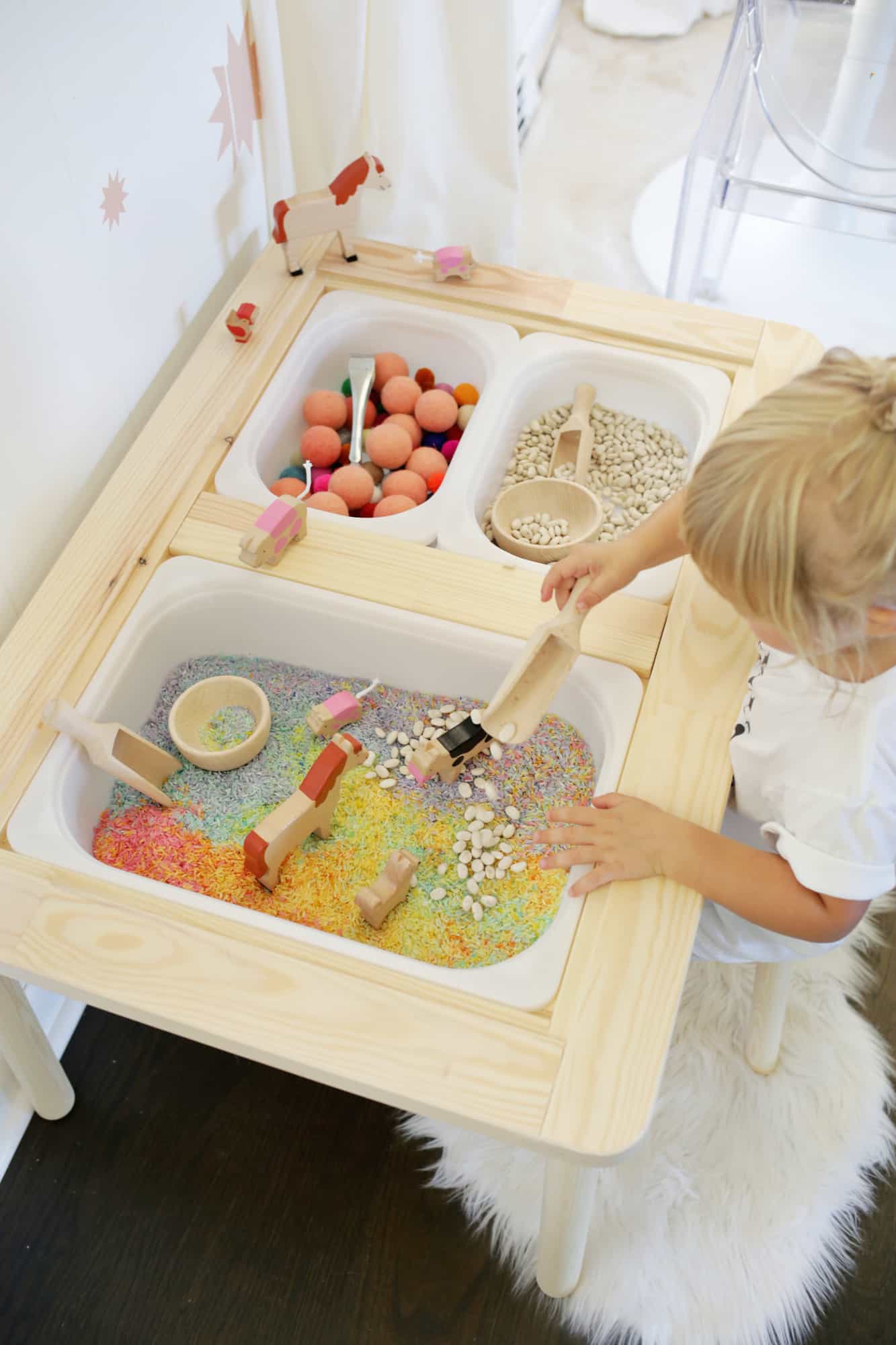
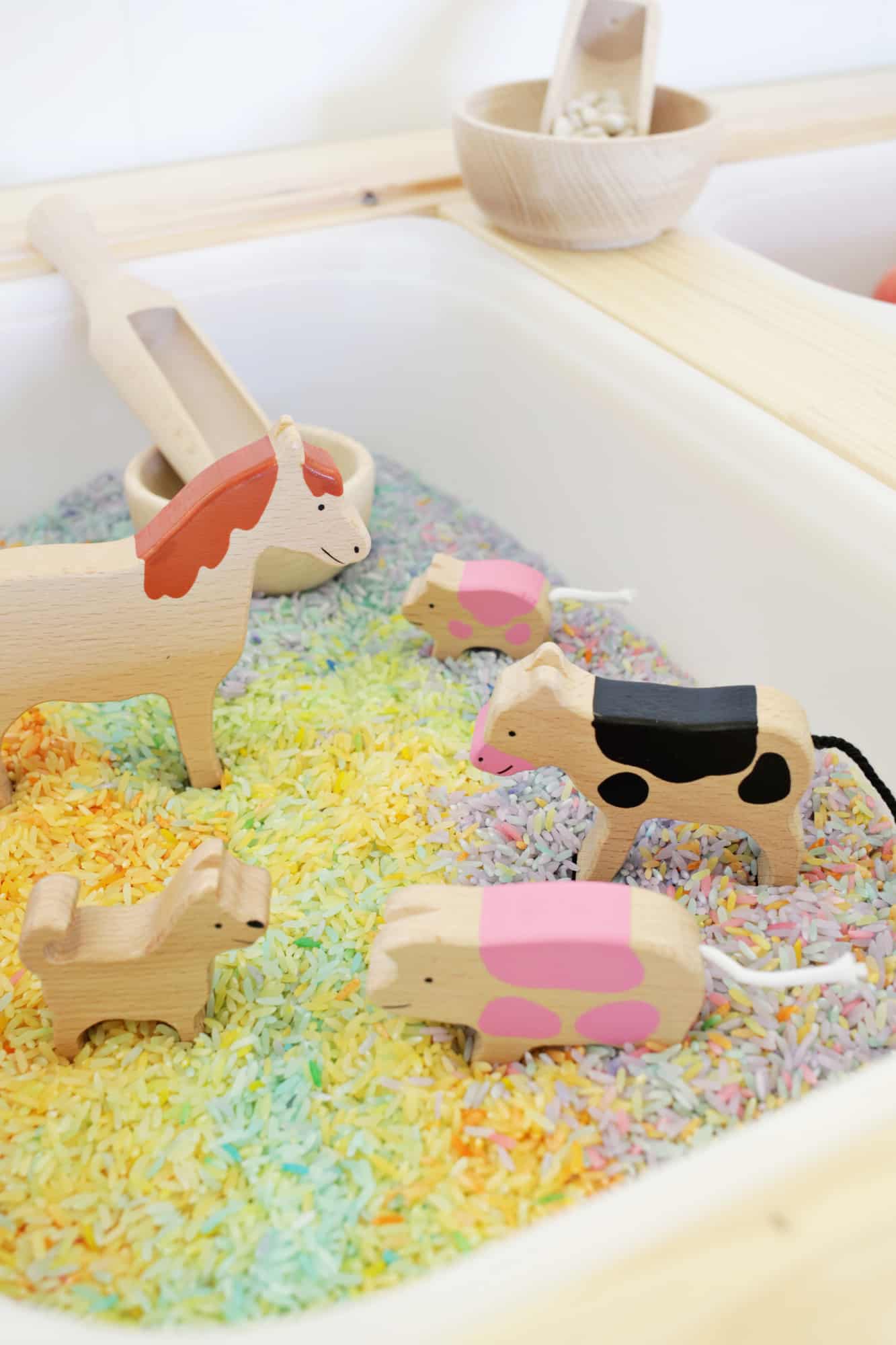 The Activities: There are tons of things you can do with your sensory bins! Just the act of scooping and pouring or moving items from one location to the next is enough for most toddlers, so they can have fun with just bowls and scoops. Lola learned to use tongs recently by picking up pom poms one at a time and moving them to another container, so it can help kids learn fine motor skills by practicing tasks like that. It’s also fun to color coordinate your dyed rice to create a blue waterscape for marine animals, green grass for farm animals, etc., or just use whatever colors you want to bury little cars or figurines to find, dig out, and rescue one at a time (little wooden animals like these are great for sensory bin play). It’s amazing how excited they get to spot a tail or head of an animal peeking out of the rice! There’s also lots of fun ideas online where people use their bins to paint watercolors on snow mounds or foam bubbles—it can get pretty magical!
The Activities: There are tons of things you can do with your sensory bins! Just the act of scooping and pouring or moving items from one location to the next is enough for most toddlers, so they can have fun with just bowls and scoops. Lola learned to use tongs recently by picking up pom poms one at a time and moving them to another container, so it can help kids learn fine motor skills by practicing tasks like that. It’s also fun to color coordinate your dyed rice to create a blue waterscape for marine animals, green grass for farm animals, etc., or just use whatever colors you want to bury little cars or figurines to find, dig out, and rescue one at a time (little wooden animals like these are great for sensory bin play). It’s amazing how excited they get to spot a tail or head of an animal peeking out of the rice! There’s also lots of fun ideas online where people use their bins to paint watercolors on snow mounds or foam bubbles—it can get pretty magical!
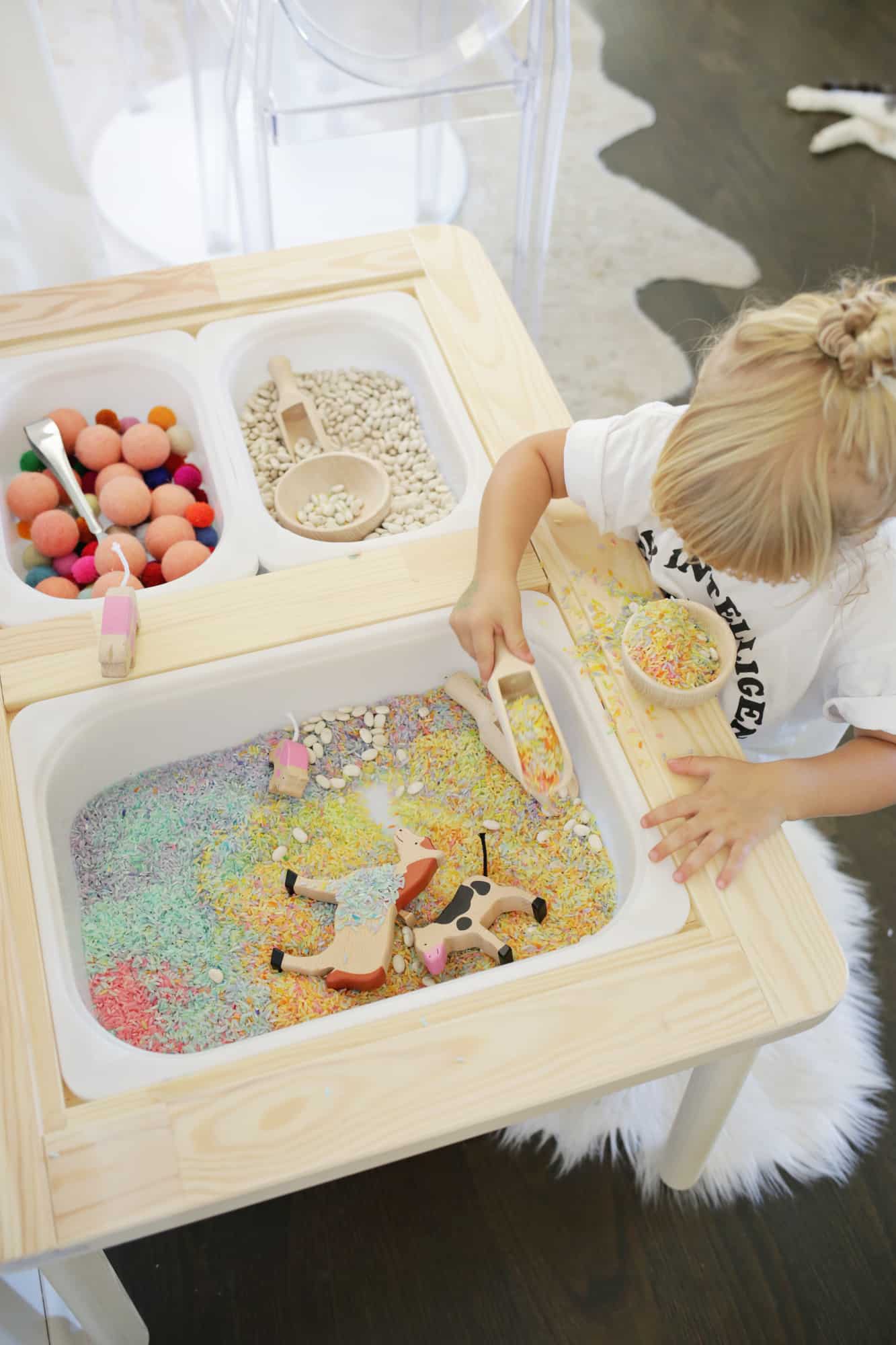 The Cleanup: OK, OK, I already know that a lot of you are thinking, “I bet that is fun for kids (and a lot of cleanup for me!)” and I totally get your point. It’s true that it’s probably impossible to do a sensory bin activity without some cleanup involved, so here are a few ideas to help you keep the cleanup session afterwards to a minimum:
The Cleanup: OK, OK, I already know that a lot of you are thinking, “I bet that is fun for kids (and a lot of cleanup for me!)” and I totally get your point. It’s true that it’s probably impossible to do a sensory bin activity without some cleanup involved, so here are a few ideas to help you keep the cleanup session afterwards to a minimum:
1. Take individual bins out of the table for water/dirt/sand play in the tub and then rinse the kid and tub out after.
2. Take the table outside for messier play (use a leaf blower to blow away dirt or sand play).
3. Use a splash mat or drop cloth underneath the table for faster cleanup.
4. Only use pom poms and balls rather than smaller/finer grain materials.
5. Seal off any small gaps between the bins and table with duct tape so the finer grain materials can’t fall through to the floor.
And the best one in my opinion …
6. Have the kid help you clean up! It’s great for kids to learn to put away their own toys because it not only helps you in the long run (although it can take longer for sure when they are first learning to help!), but if you’ve ever seen how proud a toddler can be because they helped you like a “big” kid, it can be a good confidence booster for them too. Maybe a little cleaning set just like the grownups use would be helpful too?
Sometimes kids are just messy when they have fun though, so don’t forget it’s all for a good cause!
Like I said, I love that we choose a sensory table that we can convert back into a tabletop easily for other kinds of play, so it’s great to have that level of multi-functionality. Whether you are new to the idea of sensory bins or not, hope you found some ideas to help make playtime a little more fun for everyone at your house! xo. Laura





12 Comments
Hi! Can you include a link for the wooden animal toys? Thanks!
Such a pretty little setup! I love the wooden toy animals you picked too – super artsy! ❤️✨
Charmaine Ng | Architecture & Lifestyle Blog
http://charmainenyw.com
This table is so sweet. Love the simplicity and that it converts back to flat table. I want to make one for my kiddos!
Love the setup and accessibility for children. I encourage you to seek out materials that are not food. Using food sends a message that food can be a toy. Let’s teach children the value of food and share ways to ensure that we are helping those without means to get/grow the food they need.
AAARGH I wrote a long reply and it got deleted.
While on some level I do agree with you, there are also a couple of things to keep in mind: most of these sensory materials can be stored for years (rice, cereals, legumes) and reused as often as you want. Second, they can be composted. In a world where 90% of toys are made of plastic, this is a HUGE improvement.
I personally avoid to use food that has to be thrown out after one use (cooked spaghetti) unless it’s something that has expired. But for example I will try chia seeds slime, sooner or later, because it is still better than the glue equivalent, environmentally speaking. Granted, I won’t do it often, but for a one time only I think it’s worth it.
Jennifer I have to respectfully disagree with you. I think not having them play with sensory bins at the kitchen table removes that attachment to dining. Using dry food items, especially ones close to or past expiry, is a very responsible way to reduce waste. Determining whether a child is ready for sensory bin play is up to the parent, since kids are all different and some may have a tendency to put things in their mouth or up their nose etc and and others grow out of that stage quickly or do not have that tendency.
Absolutely agree. I actually felt that on the pasta post too.
Thanks for the idea. My 18 month old loves tactile play with pebbles, sand, etc. Am curious how old is your daughter and/or do you have a sense of what age rage is best suited for this type of set up?
This is SO CUTE Laura!!! I want to make one!
I totally just bought this table, stool and bins after reading this post! Thank you for the idea!!
This is such a cute idea and I would think it would be a great play corner for city kids. However, if you have a yard or woods or even a park, use the outdoors as sensory play when possible (it’s free!). I grew up playing outside and still greatly enjoy and care about nature because of this. I used to catch salamanders and crayfish in the creeks, turn over rocks, climb trees, etc. Pine cones, rocks, leaves from trees, sticks, lichen, et al all have fun textures as well and help connect us to our environment.
I made this for my daughter for her birthday! She has Down syndrome and LOVES her sensory bin st school. Can’t wait for her to open and enjoy it at home! Thanks!